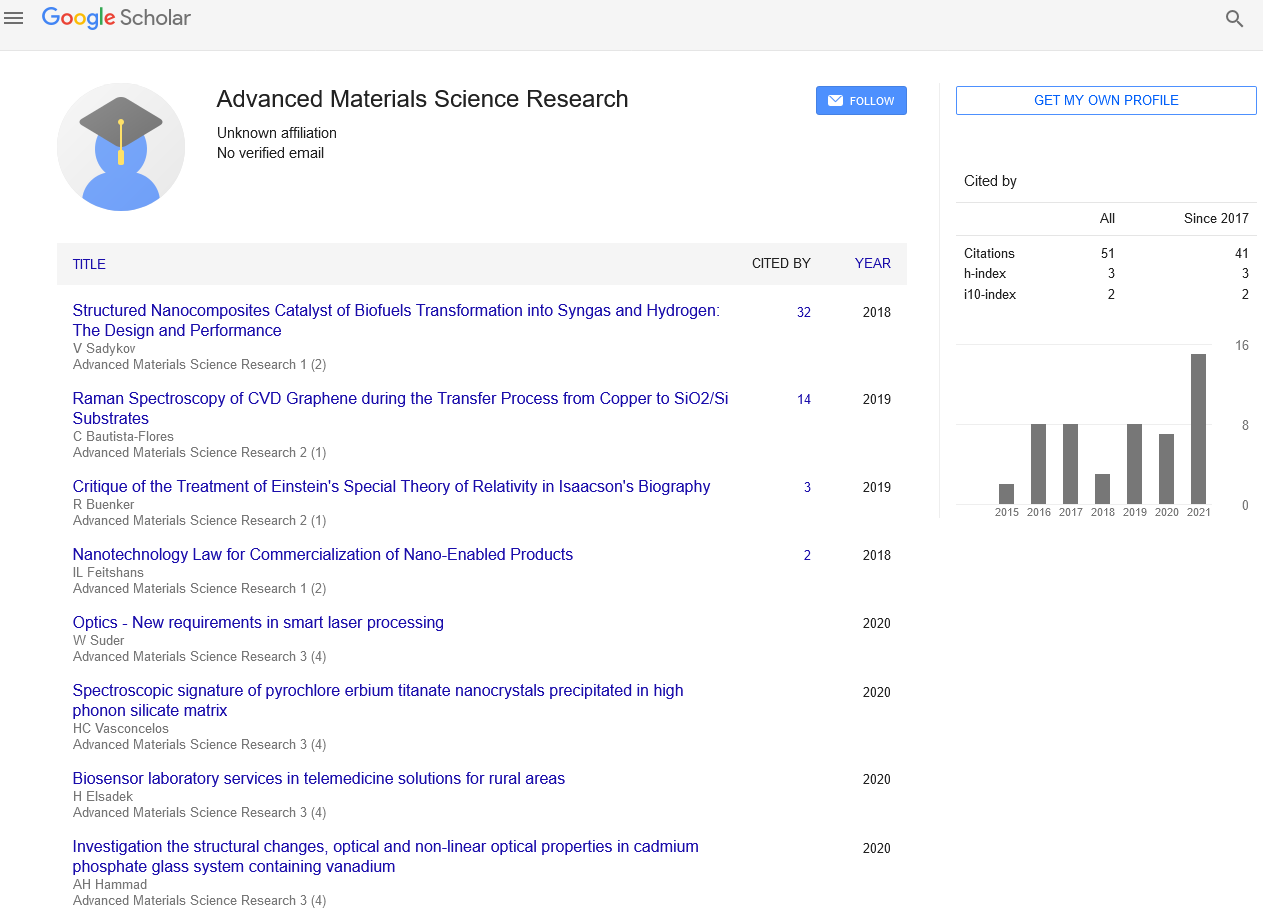Editorial - Advanced Materials Science Research (2023) Volume 6, Issue 4
Harnessing the Power of Photovoltaic Materials: The Future of Sustainable Energy
Mohesh Jen*
Department of Electrical Engineering, Shandong University, China
Department of Electrical Engineering, Shandong University, China
E-mail: Jmohesh6@gmail.com
Received: 01-Aug-2023, Manuscript No. AAAMSR-23-108059; Editor assigned: 03-Aug-2023, Pre-QC No. AAAMSR-23-108059 (PQ); Reviewed: 17-Aug-2023, QC No. AAAMSR-23-108059; Revised: 22-Aug-2023, Manuscript No. AAAMSR-23-108059 (R); Published: 29-Aug-2023; DOI: 10.37532/ aaasmr.2023.6(4).64-66
Abstract
The increasing global demand for renewable energy sources has led to rapid advancements in photovoltaic (PV) materials research. Photovoltaic materials are the essential components of solar cells that directly convert sunlight into electricity. This abstract provides a concise overview of recent developments and the future prospects of PV materials. In recent years, extensive efforts have been made to improve the efficiency, cost-effectiveness, and sustainability of photovoltaic technologies. Researchers have focused on a wide range of materials, including traditional silicon-based cells, as well as emerging thin-film, organic, and perovskite-based technologies. Each of these materials offers unique advantages and challenges, and the ongoing research seeks to optimize their performance and stability.Silicon, being the most established PV material, continues to dominate the market due to its reliability and efficiency. However, the cost of siliconbased cells remains a challenge, prompting scientists to explore alternative materials. Thinfilm technologies, such as cadmium telluride (CdTe) and copper indium gallium selenide (CIGS), have shown promise as cost-effective solutions Their potential for lightweight, flexible, and scalable applications makes them suitable for various niche markets. Organic photovoltaic materials, based on organic polymers or small molecules, hold promise for low-cost, solution-processable solar cells. Their inherent flexibility and potential for transparent and flexible devices have garnered significant interest. Researchers continue to improve their efficiency and stability through innovative molecular engineering and device architectures. Perovskite solar cells have witnessed a remarkable rise in efficiency, surpassing many established technologies in a relatively short time. The tenable bandgap, ease of fabrication, and low-cost potential of perovskite materials have captured the attention of the scientific community.
Keywords
Photovoltaic • Renewable energy • Perovskite materials • Global energy • Copper indium gallium selenide
Introduction
In the quest for clean and sustainable energy, photovoltaic (PV) materials have emerged as one of the most promising technologies. These materials have the unique ability to convert sunlight into electricity, making them a key player in the transition towards a low-carbon future. This article explores the fascinating world of photovoltaic materials, their types, applications, and the pivotal role they play in shaping the renewable energy landscape. Despite significant progress in PV materials, there are still hurdles to overcome. Researchers strive to improve material durability, reduce manufacturing costs, and enhance overall energy conversion efficiency. Additionally, addressing environmental concerns associated with certain materials and optimizing recycling processes are paramount for long-term sustainability [1]. Collaborative efforts from academia, industry, and policymakers are essential to drive innovation and realize the full potential of photovoltaic technologies in addressing the global energy challenge. Nevertheless, challenges related to long-term stability and toxicity remain key areas of investigation. The incorporation of nanostructured materials, like quantum dots and nanowires, has opened new possibilities for enhancing light absorption and charge separation in solar cells. These nano-engineered materials offer exciting prospects for further boosting PV efficiency [2,3].
Understanding photovoltaic materials
Photovoltaic materials, commonly referred to as solar cells, are at the heart of solar energy generation. They absorb photons from sunlight and convert the solar energy into electrical energy through a process known as the photovoltaic effect. When light strikes the surface of a photovoltaic material, it dislodges electrons, creating an electric current that can be harnessed for various purposes [4].
Types of photovoltaic materials
There are various types of photovoltaic materials, each with its unique properties and applications:
Silicon-based solar cells: Silicon is the most commonly used material for solar cells due to its abundance and high efficiency. Silicon solar cells can be further classified into monocrystalline, polycrystalline, and amorphous silicon cells, each offering a different balance of cost, efficiency, and performance [5].
Thin-film solar cells: These solar cells use materials like cadmium telluride (CdTe), copper indium gallium selenide (CIGS), and amorphous silicon (a-Si). Thin-film cells are lightweight, flexible, and have the potential to be manufactured using low-cost processes.
Perovskite solar cells: Perovskite materials, named after their crystal structure, have garnered significant attention in recent years for their remarkable efficiency improvements and ease of fabrication. They have the potential to revolutionize the solar industry, offering higher efficiency and lower manufacturing costs [6].
Organic photovoltaic materials: Organic solar cells, often referred to as "plastic solar cells," are lightweight and can be produced using cost-effective printing techniques. While their efficiency is currently lower than traditional solar cells, ongoing research holds promise for future advancements.
Applications of photovoltaic materials
Photovoltaic materials find a wide range of applications, from large-scale solar farms to portable electronic devices:
Solar power plants: PV materials are used in solar power plants to generate electricity at a utility scale, providing a renewable and sustainable energy source for communities and industries [7].
Residential and commercial solar panels: Solar panels installed on rooftops of homes and businesses allow for on-site electricity generation, reducing dependency on the grid and lowering carbon footprints.
Portable electronic devices: Solar cells integrated into portable gadgets like smartphones, tablets, and smart watches enable them to recharge through sunlight, enhancing their sustainability and reducing the need for conventional power sources.
Off-grid applications: In remote areas where access to the electricity grid is limited, solarpowered systems utilizing photovoltaic materials offer a viable solution to meet basic energy needs [8].
Advancements and challenges
The photovoltaic industry has witnessed remarkable advancements over the years, including increased efficiency, reduced manufacturing costs, and improved environmental sustainability. Researchers continue to explore novel materials, such as perovskite, quantum dots, and nanomaterials, to push the boundaries of solar cell technology.
However, challenges persist. The intermittent nature of sunlight necessitates efficient energy storage systems to ensure a continuous power supply. Additionally, recycling and disposal of PV materials, especially older generations, pose environmental concerns [9].
The future of photovoltaic materials
The future of photovoltaic materials is promising as technology continues to evolve. Advancements in energy storage solutions, coupled with the integration of smart grid systems, will enable a more stable and reliable solar energy infrastructure. Moreover, emerging concepts like tandem solar cells, which combine multiple materials to capture a broader spectrum of sunlight, offer higher efficiency and greater performance [10].
Conclusion
Photovoltaic materials have ushered in a new era of sustainable energy, offering a viable alternative to conventional fossil fuels. With ongoing research and innovation, the efficiency, cost-effectiveness, and versatility of photovoltaic materials are expected to improve further, driving the global transition towards a greener and more sustainable future. As we harness the power of sunlight through these remarkable materials, we move closer to a world powered by clean and renewable energy.
References
- Berggren K, Likharev KK, Strukov DB et al. Roadmap on emerging hardware and technology for machine learning. Nat Nanotechnol.32, 012002(2020).
- Kerner J, Dogan A, Recum VH. Machine learning and big data provide crucial insight for future biomaterials discovery and research.Acta Biomater. 130, 54-65(2021).
- Paula T, Hammond H, Shukla A et al. Layer-by-layer biomaterials for drug delivery.Annu Rev Biomed Eng.22, 1-24(2020).
- Nayeem A, Clements LM, Hasan A et al. 3D Bioprinted cancer models: Revolutionizing personalized cancer therapy.Transl Oncol.14, 101015(2021).
- Kar, Abhinanda. Wearable and implantable devices for drug delivery: Applications and challenges.Biomaterials.283, 121435(2022).
- Christina M, Geiselhart K, Kowollik CB et al. Untapped potential for debonding on demand: the wonderful world of azo-compounds.Mater Horiz. 5,162-183(2018).
- Lynn J. Synthetic biology meets bioprinting: enabling technologies for humans on Mars (and Earth).BiochemSocTrans. 44, 1158-1164(2016).
- Sharma J, Swati M, Basu B. Biomaterial’s assisted reconstructive urology: The pursuit of an implantable bioengineered neo-urinary bladder.Biomaterials.281 121331(2022).
- Ghomi ER, Nourbakhsh N, Kenari AM et al. Collagen‐based biomaterials for biomedical applications.Appl Bio Mater. 109, 1986-1999(2021).
- Kirschner CM, Anseth KS. Hydrogels in healthcare: from static to dynamic material microenvironments.Acta Mater.61,931-944(2013).
Indexed at, Google Scholar, Crossref
Indexed at, Google Scholar, Crossref
Indexed at, Google Scholar, Crossref
Indexed at, Google Scholar, Crossref
Indexed at, Google Scholar, Crossref
Indexed at, Google Scholar, Crossref
Indexed at, Google Scholar, Crossref
Indexed at, Google Scholar, Crossref
Indexed at, Google Scholar, Crossref

